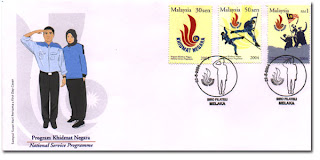 The 30 sen stamp features illustrations of two ships from Malaya and China. These ships symbolise the start of the relationship between Malacca and China 600 years ago. Diplomatic relationship were built based on the official visit of the famed Admiral Cheng Ho from China to Malacca in 1405. This sparked the growth of trade relations between the two countries and Malaya became the port of choice for many tradesmen from China. The ship gracing the Malaysian stamp is called 'Lanchara' and it was not only a trade ship but could turn into a battleship.
The 30 sen stamp features illustrations of two ships from Malaya and China. These ships symbolise the start of the relationship between Malacca and China 600 years ago. Diplomatic relationship were built based on the official visit of the famed Admiral Cheng Ho from China to Malacca in 1405. This sparked the growth of trade relations between the two countries and Malaya became the port of choice for many tradesmen from China. The ship gracing the Malaysian stamp is called 'Lanchara' and it was not only a trade ship but could turn into a battleship. Two hands locked in a firm handshake is the perfect symbol of the close relationship between Malaysia and China. As partners in trade, tourism and technology, Malaysia and China have helped each other develop these sectors extensively. The Chinese and Malaysian currencies form the backdrop of the Malaysian stamp, alluding to the importance of trade between the two nations. A unique feature of this stamp is the inclusion of both the Malaysian and Chinese flags, a feature that is rarely used in stamps. Both the stamps are adorned with a drawing of trade ship, symbolising the start of relations between Malaysia and China.
Two hands locked in a firm handshake is the perfect symbol of the close relationship between Malaysia and China. As partners in trade, tourism and technology, Malaysia and China have helped each other develop these sectors extensively. The Chinese and Malaysian currencies form the backdrop of the Malaysian stamp, alluding to the importance of trade between the two nations. A unique feature of this stamp is the inclusion of both the Malaysian and Chinese flags, a feature that is rarely used in stamps. Both the stamps are adorned with a drawing of trade ship, symbolising the start of relations between Malaysia and China.The miniture sheet is very unique because it features two mosques that can be found in Malaysia and China. The Niujie Mosque is the oldest and biggest mosque in Beijing, China and it has been in existence for over 1000 years. Its beautiful architecture is a striking combination of Chinese design and Islamic features and was masterminded by an Arab scholar during the Liao Dynasty.
Tha Kampung Hulu Mosque from Malaysia can be found in the state of Malacca. It was built in 1728 during the Dutch occupation and was built to replace the first mosque of the city. Its architecture appears typically Chinese, inspired by the pagodas of China.
Technical Details
 Date of Issue : 31-May-2004
Date of Issue : 31-May-2004Stamp Value : 30 Sen (2 Designs); RM1.00 (2 Designs)
Perforation : 14
Sheet Content : 20 Stamps
Stamp Size : 30mm X 40mm
Miniature Sheet Denomination : RM2.00
Miniature Sheet Size : 100mm X 70mm
Stamp Size in Miniature Sheet : 60mm X 40mm
Paper : Watermarked, Phospor Coated
 Printing Process : Lithography
Printing Process : LithographyStamp Designer : Hazel Design
Printer : Percetakan Keselamatan Nasional Sdn. Bhd.
First Day Cover Value : 30 Sen
Presentation Pack Value : RM 4.20
Folder Value : RM 5.00














